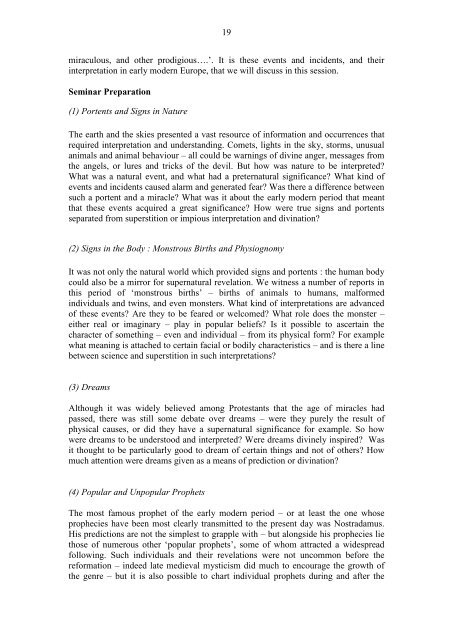Ritual, Myth and Magic in Early Modern Europe - University of Reading
Ritual, Myth and Magic in Early Modern Europe - University of Reading
Ritual, Myth and Magic in Early Modern Europe - University of Reading
You also want an ePaper? Increase the reach of your titles
YUMPU automatically turns print PDFs into web optimized ePapers that Google loves.
19<br />
miraculous, <strong>and</strong> other prodigious….‘. It is these events <strong>and</strong> <strong>in</strong>cidents, <strong>and</strong> their<br />
<strong>in</strong>terpretation <strong>in</strong> early modern <strong>Europe</strong>, that we will discuss <strong>in</strong> this session.<br />
Sem<strong>in</strong>ar Preparation<br />
(1) Portents <strong>and</strong> Signs <strong>in</strong> Nature<br />
The earth <strong>and</strong> the skies presented a vast resource <strong>of</strong> <strong>in</strong>formation <strong>and</strong> occurrences that<br />
required <strong>in</strong>terpretation <strong>and</strong> underst<strong>and</strong><strong>in</strong>g. Comets, lights <strong>in</strong> the sky, storms, unusual<br />
animals <strong>and</strong> animal behaviour – all could be warn<strong>in</strong>gs <strong>of</strong> div<strong>in</strong>e anger, messages from<br />
the angels, or lures <strong>and</strong> tricks <strong>of</strong> the devil. But how was nature to be <strong>in</strong>terpreted?<br />
What was a natural event, <strong>and</strong> what had a preternatural significance? What k<strong>in</strong>d <strong>of</strong><br />
events <strong>and</strong> <strong>in</strong>cidents caused alarm <strong>and</strong> generated fear? Was there a difference between<br />
such a portent <strong>and</strong> a miracle? What was it about the early modern period that meant<br />
that these events acquired a great significance? How were true signs <strong>and</strong> portents<br />
separated from superstition or impious <strong>in</strong>terpretation <strong>and</strong> div<strong>in</strong>ation?<br />
(2) Signs <strong>in</strong> the Body : Monstrous Births <strong>and</strong> Physiognomy<br />
It was not only the natural world which provided signs <strong>and</strong> portents : the human body<br />
could also be a mirror for supernatural revelation. We witness a number <strong>of</strong> reports <strong>in</strong><br />
this period <strong>of</strong> ‗monstrous births‘ – births <strong>of</strong> animals to humans, malformed<br />
<strong>in</strong>dividuals <strong>and</strong> tw<strong>in</strong>s, <strong>and</strong> even monsters. What k<strong>in</strong>d <strong>of</strong> <strong>in</strong>terpretations are advanced<br />
<strong>of</strong> these events? Are they to be feared or welcomed? What role does the monster –<br />
either real or imag<strong>in</strong>ary – play <strong>in</strong> popular beliefs? Is it possible to ascerta<strong>in</strong> the<br />
character <strong>of</strong> someth<strong>in</strong>g – even <strong>and</strong> <strong>in</strong>dividual – from its physical form? For example<br />
what mean<strong>in</strong>g is attached to certa<strong>in</strong> facial or bodily characteristics – <strong>and</strong> is there a l<strong>in</strong>e<br />
between science <strong>and</strong> superstition <strong>in</strong> such <strong>in</strong>terpretations?<br />
(3) Dreams<br />
Although it was widely believed among Protestants that the age <strong>of</strong> miracles had<br />
passed, there was still some debate over dreams – were they purely the result <strong>of</strong><br />
physical causes, or did they have a supernatural significance for example. So how<br />
were dreams to be understood <strong>and</strong> <strong>in</strong>terpreted? Were dreams div<strong>in</strong>ely <strong>in</strong>spired? Was<br />
it thought to be particularly good to dream <strong>of</strong> certa<strong>in</strong> th<strong>in</strong>gs <strong>and</strong> not <strong>of</strong> others? How<br />
much attention were dreams given as a means <strong>of</strong> prediction or div<strong>in</strong>ation?<br />
(4) Popular <strong>and</strong> Unpopular Prophets<br />
The most famous prophet <strong>of</strong> the early modern period – or at least the one whose<br />
prophecies have been most clearly transmitted to the present day was Nostradamus.<br />
His predictions are not the simplest to grapple with – but alongside his prophecies lie<br />
those <strong>of</strong> numerous other ‗popular prophets‘, some <strong>of</strong> whom attracted a widespread<br />
follow<strong>in</strong>g. Such <strong>in</strong>dividuals <strong>and</strong> their revelations were not uncommon before the<br />
reformation – <strong>in</strong>deed late medieval mysticism did much to encourage the growth <strong>of</strong><br />
the genre – but it is also possible to chart <strong>in</strong>dividual prophets dur<strong>in</strong>g <strong>and</strong> after the

















